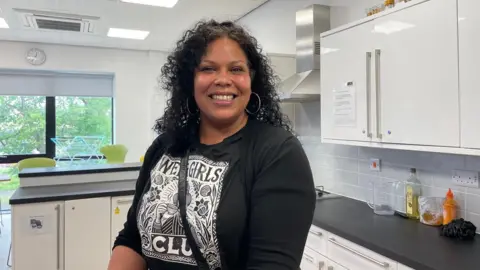Business
Yellow stickers and fridge hacks: How to feed children for less in the holidays holidays

Cost of living correspondent
 Getty Images
Getty ImagesThe school summer holidays means many parents face the task of cooking up lunches and snacks for children eating most of their meals at home for six weeks.
It can prove costly especially as food prices are rising faster now than at any point in the last year. School dinners are often subsidised so doing it yourself can get pricey.
Some parents have shared how meticulous planning and creative cooking has been helping them keep their shopping bill down.
Fill your freezer with yellow-sticker food

For mum-of-two Evelyn buying reduced items is key. “I’m not afraid of a yellow sticker, especially for my meat, that’s what your freezer is for,” she says.
At home in Gorton, in East Manchester, she’s been preparing for the summer holidays for months, buying reduced items to pop in the freezer and use when there are more mouths in the house to feed.
She has a 12-year-old daughter who gets free school meals during term time and a 19-year-old son who’s back home from university for the holidays.
“The snacking is immense,” she says.
But like Colette, she’s determined not to waste anything. “When you’ve got things going off, try and make something else out of them. Dip fruit into yoghurts, bang them in the freezer and you’ve got nice little frozen berry yoghurt snacks.”
Evelyn receives a £50 voucher to help with the cost of summer holiday food from Manchester City Council issued by her daughter’s school. She says they are a “big help”, particularly as they are not tied to one supermarket, so she can shop around for the best deals.
Food prices increased by 4.5% compared to June last year, and it’s expected the next set of official figures will show a further rise in July and August.
Benefit payments went up in April and after taking inflation into account, average wages grew by 1.5% between April and June.
But rent and mortgages rises, as well as increases in the cost of summer holiday clubs or childcare means many families say they aren’t feeling any better off.
Put food for each day in a seperate bag

Laura is out of work at the moment and has three children who she describes as “eating machines” who receive free school meals during term time.
But in the school holidays “sometimes we’ve got plenty of food, and sometimes we don’t, so you have to get creative,” she says.
Her tactic is to see what food she has, and put it into separate bags for each day, to help make sure the food lasts all week.
She says putting food in high kitchen cupboards – out of reach of the children – means the snacks don’t all disappear in one go.
“It can be really really hard when you’re having to scrimp and save and spend so much time thinking and organising and figuring out where the food is going to come from,” she says.
Laura says her local pantry the Bread And Butter Thing in South Manchester has been “a lifeline”.
She pays £8.50 for three bags of surplus food from supermarkets, farms and wholesalers. What’s inside is pot-luck but there is always fresh fruit and veg.
“It means I can put something on the table that they are going to want to eat and that’s financially viable,” she said.
The UK’s biggest food distribution network Fareshare says it has already supplied ingredients for 400,000 more meals this school holiday compared to last summer.
Child Poverty Action Group is among charities warning the current funding is not enough to help all the households that are struggling.
Order your fridge by use by date

Colette is mum to seven-year old Mary and 14-year-old Henry as has previously spoken to us about high prices in supermarkets.
She lives in south Manchester and juggles three part-time jobs as a music teacher and carer. She gets paid for her school-based work at the start of each term and says making the money last over the summer holidays is always difficult.
“We have to be clever and careful about how we use the food,” she says. “Which is no different to normal it’s just there’s more meals to make out of what we’ve got”.
There’s one basic rule she sticks by: “We don’t waste anything,” she says. “Even crusts.”
“It sounds really silly but it’s having a system in the fridge of making sure the stuff that’s at the front is the stuff that needs using first,” she says.
“The kids are not going to rummage around and look at use by dates, but if it’s at the front I know that’s the one that needs using first.”
The family try and batch cook too. Henry joined in to make a bolognaise this week, and now there’s an extra portion in the freezer for another day.

How to get help with school summer holiday food
- In England and Wales low-income families should have access to free food at holiday schemes through the Holiday Activities and Food Programme.
- Some councils also give food vouchers directly over the holidays through a government pot called the Household Support Fund.
- In Scotland some councils are also offering extra free school meal payments to low-income families over the school holidays. However, in Northern Ireland there is currently no funding in place, as “holiday hunger” payments were stopped in 2023 as a cost cutting measure.
- Food banks provide emergency help for those in dire straights, but an increasing number of Food Pantries, or Food Clubs now exist across the UK. Here members pay a small fee, and are given a fixed number of bags of food each week.
- Some apps like Olio and TooGoodToGo allow you to get cheap or free food from cafes and shops that would otherwise go to waste at the end of the day.
Business
Key Financial Deadlines That Have Been Extended For December 2025; Know The Last Date

New Delhi: Several crucial deadlines have been extended in December 2025, including ITR for tax audit cases, ITR filing and PAN and Aadhaar linking. These deadlines will be crucial in ensuring that your financial affairs operate smoothly in the months ahead.
Here is a quick rundown of the important deadlines for December to help you stay compliant and avoid last-minute hassles.
ITR deadline for tax audit cases
The Central Board of Direct Taxes has extended the due date of furnishing of return of income under sub-Section (1) of Section 139 of the Act for the Assessment Year 2025-26 which is October 31, 2025 in the case of assessees referred in clause (a) of Explanation 2 to sub-Section (1) of Section 139 of the Act, to December 10, 2025.
Belated ITR filing deadline
A belated ITR filing happens when an ITR is submitted after the original due date which is permitted by Section 139(4) of the Income Tax Act. Filing a belated return helps you meet your tax obligations, but it involves penalties. You can only file a belated return for FY 2024–25 until December 31, 2025. However, there will be a late fee and interest charged.
PAN and Aadhaar linking deadline
The Income Tax Department has extended the deadline to link their PAN with Aadhaar card to December 31, 2025 for anyone who acquired their PAN using an Aadhaar enrolment ID before October 1, 2024. If you miss this deadline your PAN will become inoperative which will have an impact on your banking transactions, income tax return filing and other financial investments.
Business
Stock Market Live Updates: Sensex, Nifty Hit Record Highs; Bank Nifty Climbs 60,000 For The First Time

Stock Market News Live Updates: Indian equity benchmarks opened with a strong gap-up on Monday, December 1, touching fresh record highs, buoyed by a sharp acceleration in Q2FY26 GDP growth to a six-quarter peak of 8.2%. Positive cues from Asian markets further lifted investor sentiment.
The BSE Sensex was trading at 85,994, up 288 points or 0.34%, after touching an all-time high of 86,159 in early deals. The Nifty 50 stood at 26,290, higher by 87 points or 0.33%, after scaling a record intraday high of 26,325.8.
Broader markets also saw gains, with the Midcap index rising 0.27% and the Smallcap index advancing 0.52%.
On the sectoral front, the Nifty Bank hit a historic milestone by crossing the 60,000 mark for the first time, gaining 0.4% to touch a fresh peak of 60,114.05.
Meanwhile, the Metal and PSU Bank indices climbed 0.8% each in early trade.
Global cues
Asia-Pacific markets were mostly lower on Monday as traders assessed fresh Chinese manufacturing data and increasingly priced in the likelihood of a US Federal Reserve rate cut later this month.
According to the CME FedWatch Tool, markets are now assigning an 87.4 per cent probability to a rate cut at the Fed’s December 10 meeting.
China’s factory activity unexpectedly slipped back into contraction in November, with the RatingDog China General Manufacturing PMI by S&P Global easing to 49.9, below expectations of 50.5, as weak domestic demand persisted.
Japan’s Nikkei 225 slipped 1.6 per cent, while the broader Topix declined 0.86 per cent. In South Korea, the Kospi dropped 0.30 per cent and Australia’s S&P/ASX 200 was down 0.31 per cent.
US stock futures were steady in early Asian trade after a positive week on Wall Street. On Friday, in a shortened post-Thanksgiving session, the Nasdaq Composite climbed 0.65 per cent to 23,365.69, its fifth consecutive day of gains.
The S&P 500 rose 0.54 per cent to 6,849.09, while the Dow Jones Industrial Average added 289.30 points, or 0.61 per cent, to close at 47,716.42.
Business
Global Conflicts Drive Arms Industry to $679 Billion Record Revenues – SUCH TV

Sales by the world’s top 100 arms makers reached a record $679 billion last year, as conflicts in Ukraine and Gaza fueled demand, according to researchers. Production challenges, however, continued to hamper timely deliveries.
The figure represents a 5.9 percent increase from the previous year, and over the 2015–2024 period, revenues for the top 100 arms makers have grown by 26 percent, according to a report by the Stockholm International Peace Research Institute (SIPRI).
“Last year, global arms revenues reached the highest level ever recorded by SIPRI, as producers capitalized on strong demand,” said Lorenzo Scarazzato, a researcher with the SIPRI Military Expenditure and Arms Production Programme.
Regional Trends
According to SIPRI researcher Jade Guiberteau Ricard, the growth is mostly driven by Europe, though all regions saw increases except Asia and Oceania.
The surge in Europe is linked to the war in Ukraine and heightened security concerns regarding Russia.
Countries supporting Ukraine and replenishing their stockpiles have also contributed to rising demand.
Ricard added that many European nations are now seeking to modernize and expand their militaries, creating a new source of demand.
US and European Arms Makers
The United States hosts 39 of the world’s top 100 arms makers, including the top three: Lockheed Martin, RTX (formerly Raytheon Technologies), and Northrop Grumman. US companies saw combined revenues rise 3.8 percent to $334 billion, nearly half of the global total.
European arms makers (26 companies in the top 100) recorded aggregate revenues of $151 billion, a 13 percent increase.
The Czech company Czechoslovak Group recorded the sharpest rise, with revenues jumping 193 percent to $3.6 billion, benefiting from the Czech Ammunition Initiative, which supplies artillery shells to Ukraine.
However, European producers face challenges in meeting increased demand, as sourcing raw materials has become more difficult.
Companies like Airbus and France’s Safran previously sourced half of their titanium from Russia before 2022 and have had to identify new suppliers.
Additionally, Chinese export restrictions on critical minerals have forced firms such as France’s Thales and Germany’s Rheinmetall to restructure supply chains, raising costs.
Russian Arms Industry
Two Russian arms makers, Rostec and United Shipbuilding Corporation, are among the top 100, with combined revenues rising 23 percent to $31.2 billion, despite component shortages caused by international sanctions.
Domestic demand largely offset the decline in exports. However, Russia’s arms industry faces a shortage of skilled labor, limiting its ability to sustain production rates necessary for ongoing military operations.
Israeli weapons still popular
The Asia and Oceania region was the only region to see the overall revenues of the 23 companies based there go down — their combined revenues dropped 1.2 percent to $130 billion.
But the authors stressed that the picture across Asia was varied and the overall drop was the result of by a larger drop among Chinese arms makers.
“A host of corruption allegations in Chinese arms procurement led to major arms contracts being postponed or cancelled in 2024,” Nan Tian, Director of SIPRI’s Military Expenditure and Arms Production Programme, said in a statement.
Tian added that the drop deepened “uncertainty” around China’s efforts to modernise its military.
In contrast, Japanese and South Korean weapons makers saw their revenues increase, also driven by European demand.
Meanwhile, nine of the top 100 arms companies were based in the Middle East, with combined revenues of $31 billion.
The three Israeli arms companies in the ranking accounted for more than half of that, as their combined revenues grew by 16 percent to $16.2 billion.
SIPRI researcher Zubaida Karim noted in a statement that “the growing backlash over Israel’s actions in Gaza seems to have had little impact on interest in Israeli weapons”.
-

 Sports1 week ago
Sports1 week agoWATCH: Ronaldo scores spectacular bicycle kick
-

 Entertainment1 week ago
Entertainment1 week agoWelcome to Derry’ episode 5 delivers shocking twist
-

 Politics1 week ago
Politics1 week agoWashington and Kyiv Stress Any Peace Deal Must Fully Respect Ukraine’s Sovereignty
-

 Business1 week ago
Business1 week agoKey economic data and trends that will shape Rachel Reeves’ Budget
-

 Tech6 days ago
Tech6 days agoWake Up—the Best Black Friday Mattress Sales Are Here
-

 Politics1 week ago
Politics1 week ago53,000 Sikhs vote in Ottawa Khalistan Referendum amid Carney-Modi trade talks scrutiny
-

 Fashion1 week ago
Fashion1 week agoCanada’s Lululemon unveils team Canada kit for Milano Cortina 2026
-

 Tech6 days ago
Tech6 days agoThe Alienware Aurora Gaming Desktop Punches Above Its Weight







